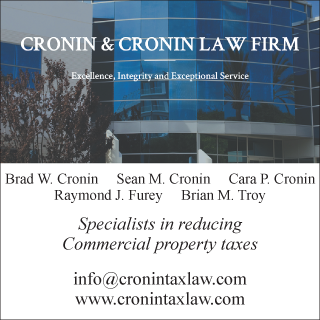Good news: Your property may be worth less than you think...for your property tax case - by Brad and Sean Cronin
The situation can arise where a property owner believes his property is so valuable that it does not make sense to pursue a reduction in their property taxes. What is often overlooked in these instances is that, while a property may have certain value to an investor, its value can be determined to be much less under the real property tax law. This does not mean that the property is actually less valuable, rather that in order for the property to be equitably assessed with other similar property types, the law requires certain rules be followed.
This circumstance occurs when a commercial owner asks how their property taxes can be reduced when they could sell the property for a value significantly higher than its assessed value. While the assessor is always attempting to find the market value of a property, unless there is an arm’s length subject sale of the property, the assessor will perform an income approach to determine value. The courts have preferred this methodology to analyzing over a cost or sales approach.
When utilizing an income approach for property tax purposes, there are certain restrictions in regards to the parameters that the assessor must stay within when calculating value. Further, each individual variable in this method of valuation must be examined in comparison to the market.
One component of the income approach that has the ability to greatly shift the conclusion of value is the capitalization rate or rate of return for the property. Property owners are often surprised to learn of the high capitalization rates utilized in property tax cases. The main reason why the difference can be so significant is that the law requires the property to be examined in its condition on taxable status date. The courts have called for a “snapshot” of the property to be taken and its value examined in that specific moment in time. This prohibits the capitalization rate to account for any prospective increase in value due to anticipated appreciation, redevelopment or rezoning of the property. Eliminating these factors requires an investor to demand a higher rate of return and therefore leads to a lower value of the property for tax purposes. Valuing the property as it exists and therefore utilizing a higher capitalization rate leads to more consistent assessments. If an assessor were tasked with projecting value of a property assuming the value will increase significantly in the future , there would be a great deal of speculation and subjectivity in regards to what that property could become. Ultimately a property owner could be taxed on something that may never come to fruition or worse, the heavy tax burden could be one of the expenses preventing the property from reaching its full development potential. Having seen the downturn that occurred post 2008 only reinforces the fact that commercial properties do not always appreciate annually and therefore should not be taxed with that assumption.
A similar approach is required with the actual expenses at the property. If the expenses are abnormally high, these figures are acceptable if it can be shown they are the result of necessary upkeep to an older building and not mismanagement by a landlord. So long as the expenses can be justified, the owner is entitled to have the actual expenses at the property deducted as part of the income analysis. Conversely, if expenses are low due to a property owner managing the building himself, there is in an opportunity to use a figure above the actual expenses so long as this amount is supported by the market.
Deducting an amount for vacancy and collection loss is another component that seems straightforward, but actually provides an opportunity for landlords whose properties are 100% occupied. The law calls for the market to be examined and a market vacancy to be deducted. This creates a tremendous opportunity for those owners who have avoided vacancies to take benefit from the market’s vacancy factor and deduct that percentage from the gross income. This deduction can be upwards of 10% depending on the property type.
By taking advantage of beneficial capitalization rates, expenses and a market vacancy allowance, property owners are able to put themselves in a position where a seemingly undervalued property in the actual real estate market, may be overassessed and entitled to significant tax refunds under the law in New York.
Brad Cronin, Esq., and Sean Cronin, Esq., are partners at Cronin & Cronin Law Firm, PLLC, Mineola, N.Y.
Suffolk County IDA supports expansion of A&Z Pharmaceuticals


The evolving relationship of environmental consultants and the lending community - by Chuck Merritt
When Environmental Site Assessments (ESA) were first part of commercial real estate risk management, it was the lenders driving this requirement. When a borrower wanted a loan on a property, banks would utilize a list of “Approved Consultants” to order the report on both refinances and purchases.










.gif)
.jpg)